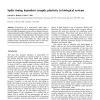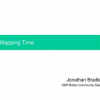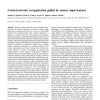84
Voted
BC
2002
15 years 26 days ago
2002
Different mechanisms that could form the molecular basis for bi-directional synaptic plasticity have been identified experimentally and corresponding biophysical models can be cons...
BC
2002
15 years 26 days ago
2002
Spike-timing-dependent plasticity (STDP) strengthens synapses that are activated immediately before a postsynaptic spike, and weakens those that are activated after a spike. To pre...
BC
2002
15 years 26 days ago
2002
Abstract. How do humans achieve the precise positioning of the feet during walking, for example, to reach the first step of a stairway? We addressed this question at the visuomotor...
BC
2002
15 years 26 days ago
2002
Association of a presynaptic spike with a postsynaptic spike can lead to changes in synaptic efficacy that are highly dependent on the relative timing of the preand postsynaptic sp...
108
click to vote
BC
2002
15 years 26 days ago
2002
The importance of the hippocampus in spatial representation is well established. It is suggested that the rodent hippocampal network should provide an optimal substrate for the stu...
126
click to vote
BC
2002
15 years 26 days ago
2002
Abstract. Sensory experience alters the functional organization of cortical networks. Previous studies using behavioral training motivated by aversive or rewarding stimuli have dem...
BC
2002
15 years 26 days ago
2002
Abstract. Recent experimental observations of spiketiming-dependent synaptic plasticity (STDP) have revitalized the study of synaptic learning rules. The most surprising aspect of ...
BC
2002
15 years 26 days ago
2002
Hebb's original postulate left two important issues unaddressed: (i) what is the effective time window between pre- and postsynaptic activity that will result in potentiation?...
93
Voted
BC
2002
15 years 26 days ago
2002
Several formulations of correlation-based Hebbian learning are reviewed. On the presynaptic side, activity is described either by a firing rate or by presynaptic spike arrival. The...




